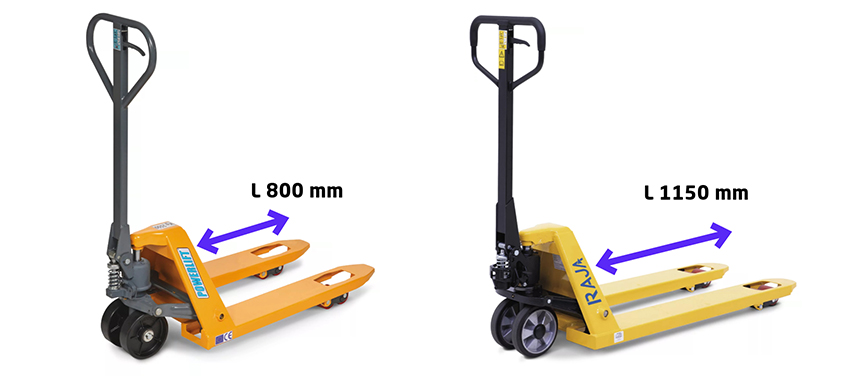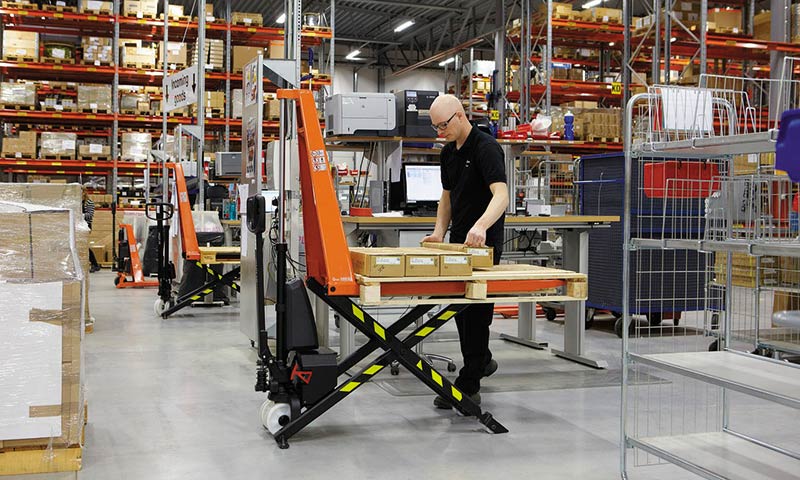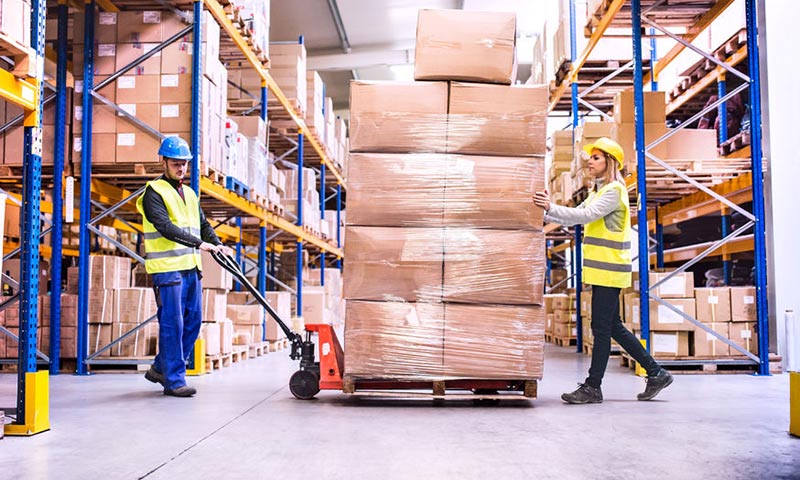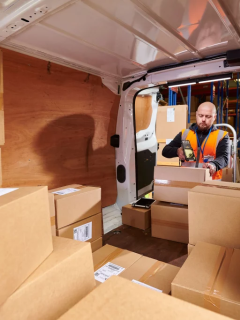Moving goods is a key process in your logistics. From truck to rack, from rack to packing table, and from packing table to loading dock… Your goods undergo a lot of shifting in and around your warehouse. The way you move those goods has an impact on the health of your logistics staff that should not be underestimated. According to international standards, lifting loads of more than 25 kg is not recommended. Do you need to move a heavy stack of goods on a pallet? Then a pallet truck is the best solution for you.
So which pallet truck is ideal for your type of warehouse, your logistics activities or the needs of your staff? Below we dive into the most important questions you should ask yourself when choosing a new pallet truck. Making the right choice will increase the productivity of your teams, improve workplace ergonomics and speed up your logistics processes.
1. In what environment do you use the pallet truck?
In your search for the perfect pallet truck or pump truck, it is important to start with this key question: in which environment will your employees use this rolling stock? Depending on your answer, you will then be able to choose a pallet truck based on the material it is made of. Let’s look at a few examples:
- Do you work in an environment with specific hygiene protocols (pharmaceutical or food sector)? Then choose a machine with an outer finish made of plastic. This is usually easier to maintain and better meets the required hygiene standards.
- Do you work in a humid environment (food industry, port areas, chemical industry)? Here, consider a stainless steel pallet truck. It is more resistant to moisture or chemicals in the long run.
- Do you work in a standard indoor environment? Then it suffices to opt for a machine made of galvanised steel.
A second determining element regarding the environment is the type of floor. On what surface will you often need to drive? This will help determine which type of wheels you should choose for your pallet truck. Usually, you have the choice of rubber or polyurethane wheels:
- Rubber wheels are quieter when driving and provide a good grip on industrial and slippery floors.
- Polyurethane wheels usually leave no marks on the floor and are especially recommended for sensitive and softer floors.
2. What goods will you move?
A second aspect that will determine your choice is the type of goods your warehousemen have to move. Just how big are these pallets? Based on these dimensions, you can then make the following choices:
- For small-sized pallets: choose a pump truck with short forks (up to 800 mm in length).
- For standard-sized pallets: choose a machine with standard forks (1150 mm length).
- For large-size pallets: choose a pallet truck with longer forks (1800 mm length).
In addition, consider the weight of your pallet load. This is because every pallet truck has a maximum load capacity. At RAJA, for example, we offer models that can support a payload of up to 2500 kg. That will already go a long way for moving most loads in your warehouse.
 ]
]
3. How high should your pallet truck be able to lift?
For point 3, let’s take a quick look at the lifting height of your machine. By default, a pallet truck can lift your goods up to about 20 cm. In most circumstances, this is more than enough to move smoothly across the floor. However, you may also need just more lifting height. This is particularly useful if you want to place the goods on the pallet truck without having to bend down.
This allows your warehouse operative to work with a straight back during loading and unloading. And that, in turn, can contribute to a reduced risk of musculoskeletal disorders (MSDs). In this case, opt for a lift table or scissor pallet truck. These special pump trucks often have a lifting height of up to 80 cm.

4. How do you ensure the safety of your operators?
Using rolling stock in and around your warehouse is never entirely without risk. It is therefore important to pay extra attention to the safety of your operators in relation to your pallet truck. When making your choice, you can therefore consider the following equipment:
- A safety valve, to indicate when there is a potential overload of the lifting mechanism,.
- A safety system for braking, for example,.
- A stabilisation system for lifting your load. This is especially useful for pallet trucks with a higher lift height,
- A multi-position control lever (for manual pallet trucks), which allows you to lift, lower and move the forks more easily.
 Take your pick from the full range of pallet trucks from RAJA here
Take your pick from the full range of pallet trucks from RAJA here
5. Do you choose a manual or electric pallet truck?
This is another question absolutely worth asking during your selection process: for your logistics operations, should you choose a manual or an electric operation? What probably won’t really surprise you is that an electric pallet truck has the advantage of making your handling considerably easier. The automated electric system allows the operator to maintain an upright posture. This can reduce the risk of strain and musculoskeletal disorders (MSA).
Along the other side, you then have the ‘manual pallet truck’. This has a hydraulic pump that relieves, but does not completely eliminate, the operator’s lifting work. The operator will still have to make some effort to lift the pallet load off the ground.
If you choose an electric pallet truck, bear in mind there is a significant difference in the cost. Buying an electric model quickly starts around €1,500. For a good manual pallet truck, the cost hovers at a starting price of € 300. On top of that purchase cost, you should also think about maintenance, service and warranty costs for your unit. A manual model usually requires much less maintenance and has cheaper replacement parts.
Finally, an electric model requires longer and more complex training before your operators can work with it independently. Of course, you also need to factor these training costs into the cost equation. The combination of ease of use and lower cost makes the manual pallet truck by far the most popular option in average warehouses and retailers.
]Finally: pallet truck, stacker or forklift?
The last question on our menu brings us to the difference between a pallet truck, stacker and forklift. It is interesting to briefly compare the differences between these devices side by side.
A pallet truck is the simplest device in terms of design and use. It is easy to operate and does not require too much maintenance. It is mainly used for moving (palletised) goods that are low to the ground. It is the entry-level model of choice for most types of warehouses.
A stacker, as the name suggests, is designed to place goods at height. This could include, for example, a pallet load that needs to be stacked high in a warehouse rack. A stacker can lift pallets up to a height of 5 metres. These devices are often more expensive than a standard pallet truck.
Finally, there is the forklift truck: the true all-rounder. It is best suited for warehouses with intensive operations, long-distance transport, and for very heavy loads (up to 8 tonnes). It can lift loads up to 8 metres high. However, the purchase cost is also very high, with entry prices around €6000.

How to: how to use a pallet truck correctly?
Have you chosen the pallet truck that perfectly meets your requirements? Great! Below we go over some handy tips that may come in handy when using your pallet truck.
- You can both push and pull a pallet truck. Since most people can push more weight than pull, it is always safer for the user to push.
- Before using a pallet truck, always check the body and the quality of the wheels. These should not be damaged. In addition, it is also good to double-check the maximum load. This is usually indicated on the unit itself.
- Use the release lever (usually near the handles) to release the hydraulic fluid. This allows the lifting forks to lower to the ground. After this, slide the forks under your load (pallet).
- Are the forks correctly located under your load? Now pull the large levers towards you repeatedly. This causes the pressure in the hydraulic fluid to increase, lifting the lifting forks off the ground. After this, you should be able to push and move the pallet truck smoothly.
 Take your pick from the full range of RAJA’s pump trucks here
Take your pick from the full range of RAJA’s pump trucks here













